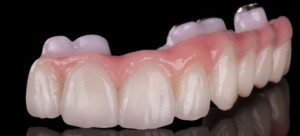Our Gold Dust ceramist Joost Jorna is back with another Q & A about his side of the case equation and what makes him love the process of fabricating a full ceramic bridge.
 Joost is Gold Dust’s resident technological advancements buff and is part of our effort to test new methods without sacrificing precision or clinical excellence. He’s back on the blog to give another inside look into what makes ceramists tick.
Joost is Gold Dust’s resident technological advancements buff and is part of our effort to test new methods without sacrificing precision or clinical excellence. He’s back on the blog to give another inside look into what makes ceramists tick.
In this interview, Joost dives into the artistic and technical efforts involved in delivering a stellar full ceramic Prettau bridge. These types of bridges add an extra level of challenge for ceramists, as they require creating both teeth and gingiva.
Process and Esthetics for a Full Ceramic Bridge
GD: What draws you to full ceramic Prettau bridges from an artistic and professional perspective?
Joost: If you look at a patient’s mouth, the line between teeth and gingiva is very definable for the esthetics. When I have a case where the bone loss and gingiva is extreme, I am uncertain about the end result. With full ceramic Prettau bridges, I have the ability to mimic the gingiva in a very natural way.
GD: Can you explain the techniques required for this bridge?
Joost: At Gold Dust Dental we have one of the best model scanners in order to scan the implant models. With the newest version of the 3Shape software, we are able to design the Prettau bridges. Besides the equipment, you need knowledge of where and how to design the teeth and gingiva. A combination of digital design, dental function and morphology are required to get the best result.
GD: What is the process of fabricating this bridge?
Joost: When we receive the impression we make the gypsum model with the analogs. We use scan markers to transfer the implant position into the digital workflow. Once we have all the information like bite and opposing teeth we can start with the digital design. For the shade of the teeth and the gingiva, the technician applies a certain staining liquid. The last step is adding ceramics onto the zirconia bridge to make it lively and translucent.
GD: What are your goals for making the best bridge possible?
Joost: I always take natural qualities as examples. This approach is called biomimicry. If the restoration is indistinguishable in the mouth, the case is successful because the patient and doctor love it!
GD: What about your approach to this bridge is valuable to dentists and their patients?
Joost: My Gold Dust team is what makes it special. We work together and devote a lot of care to our roles. Every person does their piece of the puzzle and at the end we have this great looking case. The Gold Dust is icing on the cake!
What do you enjoy most about working with ceramists on bridges? We’d love to hear from you in the comments!



Great blog post! Love the technique.